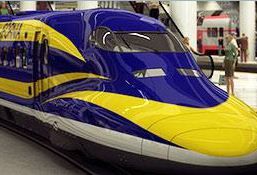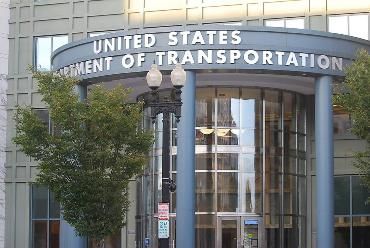Coalition backing CA bullet train is fraying
 Both in California and Washington, D.C., backers of the state’s controversy-plagued $68 billion bullet-train project are coming off a rough week. As CalWatchdog reported, a Los Angeles public hearing on proposed routes for the project in the San Fernando Valley featured heavy criticism of the California High Speed Rail Authority, and the U.S. House of Representatives acted to take back federal funding from the authority.
Both in California and Washington, D.C., backers of the state’s controversy-plagued $68 billion bullet-train project are coming off a rough week. As CalWatchdog reported, a Los Angeles public hearing on proposed routes for the project in the San Fernando Valley featured heavy criticism of the California High Speed Rail Authority, and the U.S. House of Representatives acted to take back federal funding from the authority.
These developments put project supporters on the spot in two different ways.
The Los Angeles hearing suggests attitudes about the bullet train in Los Angeles County are moving against the project. That’s what happened in Silicon Valley, where voters supported Proposition 1A in 2008 to provide $9.95 billion for a statewide bullet train system but shifted to intense opposition when the real-life effects of building a high-speed rail system through wealthy communities triggered a powerful, well-financed campaign to force the state to back off.
This and $30 billion in cost savings led Gov. Jerry Brown and the rail authority to adopt a “blended”plan in which high-speed rail would extend from Fresno to northern Los Angeles County, with slower rail on each end connecting riders to downtown San Francisco and downtown Los Angeles, respectively.
But after the rail authority decided last year to accelerate construction in Southern California, community opposition began to build. This has helped fray the loose coalition of the region’s politicians who have long supported the idea of a bullet-train system but are uncomfortable with the emerging specifics.
Is Antonovich’s proposal actually a ‘poison pill’?
Los Angeles County Supervisor Mike Antonovich — who once lobbied to make sure the bullet train’s route went through his district — now is the leading proponent of minimizing disruption to his district by tunneling through the San Gabriel Mountains for the train’s 15-mile Palmdale-to-Burbank link. Given that this would add billions of dollars in construction costs to a project that already can’t identify how it’s going to pay for its first $31 billion segment, that’s close to asking the rail authority to do the impossible. Such “poison pills” are one way for politicians to oppose a project in indirect fashion.
Antonovich’s 2014 proposal, in turn, led to concerns in January from two other elected Democrats who previously backed the bullet train project enthusiastically. This is from the Los Angeles Business Journal:
Rep. Adam Schiff came out in opposition on Thursday to a proposed alignment of the state’s high-speed rail project that would require a tunnel beneath the Angeles National Forest – damaging chances the plan will be carried out.
In a letter sent this month, Schiff, D-Burbank, and Rep. Judy Chu, D-El Monte, told California High Speed Rail Authority Dan Richard to scrap any consideration of a route under the San Gabriel Mountains between Palmdale and the San Fernando Valley because it would be harmful to the environment.
Wealthy environmentalists don’t like Antonovich’s plan. But some poor and middle-class homeowners of the San Fernando Valley don’t like the rail authority’s alternative, and they depict their fight as akin to David vs. Goliath. This is from Glendale resident Stephen Mills’ letter in Friday’s L.A. Times:
California High Speed Rail Authority board member Lou Correa said that he detected “a little bit of NIMBYism” regarding the reaction to bullet train plans. He should get used to it.
Affluent neighborhoods have successfully fought intrusive development that would have affected their quality of life, and now working-class neighborhoods are doing the same.
How much is CA project an Obama priority?
 Meanwhile, in Washington, the House’s action to pull back federal funds from the state’s high-speed project may prove as consequential as the developments in Los Angeles County. The provision was included in the Transportation, Housing and Urban Development, and Related Agencies Appropriations Act for fiscal 2016, a multibillion-dollar measure that includes many provisions the White House supports.
Meanwhile, in Washington, the House’s action to pull back federal funds from the state’s high-speed project may prove as consequential as the developments in Los Angeles County. The provision was included in the Transportation, Housing and Urban Development, and Related Agencies Appropriations Act for fiscal 2016, a multibillion-dollar measure that includes many provisions the White House supports.
If the Senate approves this funding bill, would President Obama actually veto it in the name of preserving federal grants to an embattled, increasingly unpopular project that would help only one of the 50 states?
That’s not clear. Doing so would likely prompt a sharp reaction from the Washington Post’s editorial page. It has long been a harsh critic of California’s project.
A 2011 editorial, headlined “California’s high-speed rail system is going nowhere fast,” noted that the state “hasn’t credibly identified a source of funds for the system” and questioned Gov. Jerry Brown’s enthusiasm for the project.
Chris Reed
Chris Reed is a regular contributor to Cal Watchdog. Reed is an editorial writer for U-T San Diego. Before joining the U-T in July 2005, he was the opinion-page columns editor and wrote the featured weekly Unspin column for The Orange County Register. Reed was on the national board of the Association of Opinion Page Editors from 2003-2005. From 2000 to 2005, Reed made more than 100 appearances as a featured news analyst on Los Angeles-area National Public Radio affiliate KPCC-FM. From 1990 to 1998, Reed was an editor, metro columnist and film critic at the Inland Valley Daily Bulletin in Ontario. Reed has a political science degree from the University of Hawaii (Hilo campus), where he edited the student newspaper, the Vulcan News, his senior year. He is on Twitter: @chrisreed99.
Related Articles
Analyzing Neel Kashkari’s flyer
Today the first statewide political flyer plopped into my mailbox. It’s from Neel Kashkari, running for governor as a Republican.
Feds funnel money to CA hydrogen cars
The hype surrounding electric cars is running out of gas — and the Department of Energy is directing funds toward hydrogen.
Mayor-forLife Bloomberg: Shred the Constitution
April 23, 2013 By John Seiler It’s terrible that four people were killed in Boston last week. But for that




